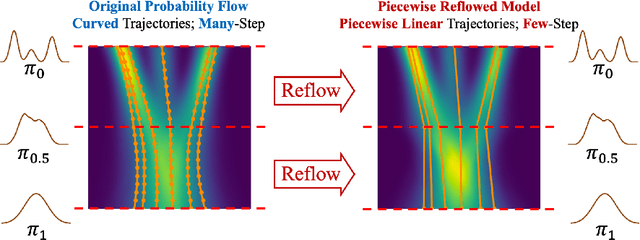Xingchao Liu
TripoSG: High-Fidelity 3D Shape Synthesis using Large-Scale Rectified Flow Models
Feb 10, 2025Abstract:Recent advancements in diffusion techniques have propelled image and video generation to unprece- dented levels of quality, significantly accelerating the deployment and application of generative AI. However, 3D shape generation technology has so far lagged behind, constrained by limitations in 3D data scale, complexity of 3D data process- ing, and insufficient exploration of advanced tech- niques in the 3D domain. Current approaches to 3D shape generation face substantial challenges in terms of output quality, generalization capa- bility, and alignment with input conditions. We present TripoSG, a new streamlined shape diffu- sion paradigm capable of generating high-fidelity 3D meshes with precise correspondence to input images. Specifically, we propose: 1) A large-scale rectified flow transformer for 3D shape generation, achieving state-of-the-art fidelity through training on extensive, high-quality data. 2) A hybrid supervised training strategy combining SDF, normal, and eikonal losses for 3D VAE, achieving high- quality 3D reconstruction performance. 3) A data processing pipeline to generate 2 million high- quality 3D samples, highlighting the crucial rules for data quality and quantity in training 3D gen- erative models. Through comprehensive experi- ments, we have validated the effectiveness of each component in our new framework. The seamless integration of these parts has enabled TripoSG to achieve state-of-the-art performance in 3D shape generation. The resulting 3D shapes exhibit en- hanced detail due to high-resolution capabilities and demonstrate exceptional fidelity to input im- ages. Moreover, TripoSG demonstrates improved versatility in generating 3D models from diverse image styles and contents, showcasing strong gen- eralization capabilities. To foster progress and innovation in the field of 3D generation, we will make our model publicly available.
Janus-Pro: Unified Multimodal Understanding and Generation with Data and Model Scaling
Jan 29, 2025Abstract:In this work, we introduce Janus-Pro, an advanced version of the previous work Janus. Specifically, Janus-Pro incorporates (1) an optimized training strategy, (2) expanded training data, and (3) scaling to larger model size. With these improvements, Janus-Pro achieves significant advancements in both multimodal understanding and text-to-image instruction-following capabilities, while also enhancing the stability of text-to-image generation. We hope this work will inspire further exploration in the field. Code and models are publicly available.
DeepSeek-V3 Technical Report
Dec 27, 2024



Abstract:We present DeepSeek-V3, a strong Mixture-of-Experts (MoE) language model with 671B total parameters with 37B activated for each token. To achieve efficient inference and cost-effective training, DeepSeek-V3 adopts Multi-head Latent Attention (MLA) and DeepSeekMoE architectures, which were thoroughly validated in DeepSeek-V2. Furthermore, DeepSeek-V3 pioneers an auxiliary-loss-free strategy for load balancing and sets a multi-token prediction training objective for stronger performance. We pre-train DeepSeek-V3 on 14.8 trillion diverse and high-quality tokens, followed by Supervised Fine-Tuning and Reinforcement Learning stages to fully harness its capabilities. Comprehensive evaluations reveal that DeepSeek-V3 outperforms other open-source models and achieves performance comparable to leading closed-source models. Despite its excellent performance, DeepSeek-V3 requires only 2.788M H800 GPU hours for its full training. In addition, its training process is remarkably stable. Throughout the entire training process, we did not experience any irrecoverable loss spikes or perform any rollbacks. The model checkpoints are available at https://github.com/deepseek-ai/DeepSeek-V3.
DeepSeek-VL2: Mixture-of-Experts Vision-Language Models for Advanced Multimodal Understanding
Dec 13, 2024



Abstract:We present DeepSeek-VL2, an advanced series of large Mixture-of-Experts (MoE) Vision-Language Models that significantly improves upon its predecessor, DeepSeek-VL, through two key major upgrades. For the vision component, we incorporate a dynamic tiling vision encoding strategy designed for processing high-resolution images with different aspect ratios. For the language component, we leverage DeepSeekMoE models with the Multi-head Latent Attention mechanism, which compresses Key-Value cache into latent vectors, to enable efficient inference and high throughput. Trained on an improved vision-language dataset, DeepSeek-VL2 demonstrates superior capabilities across various tasks, including but not limited to visual question answering, optical character recognition, document/table/chart understanding, and visual grounding. Our model series is composed of three variants: DeepSeek-VL2-Tiny, DeepSeek-VL2-Small and DeepSeek-VL2, with 1.0B, 2.8B and 4.5B activated parameters respectively. DeepSeek-VL2 achieves competitive or state-of-the-art performance with similar or fewer activated parameters compared to existing open-source dense and MoE-based models. Codes and pre-trained models are publicly accessible at https://github.com/deepseek-ai/DeepSeek-VL2.
JanusFlow: Harmonizing Autoregression and Rectified Flow for Unified Multimodal Understanding and Generation
Nov 12, 2024Abstract:We present JanusFlow, a powerful framework that unifies image understanding and generation in a single model. JanusFlow introduces a minimalist architecture that integrates autoregressive language models with rectified flow, a state-of-the-art method in generative modeling. Our key finding demonstrates that rectified flow can be straightforwardly trained within the large language model framework, eliminating the need for complex architectural modifications. To further improve the performance of our unified model, we adopt two key strategies: (i) decoupling the understanding and generation encoders, and (ii) aligning their representations during unified training. Extensive experiments show that JanusFlow achieves comparable or superior performance to specialized models in their respective domains, while significantly outperforming existing unified approaches across standard benchmarks. This work represents a step toward more efficient and versatile vision-language models.
Janus: Decoupling Visual Encoding for Unified Multimodal Understanding and Generation
Oct 17, 2024



Abstract:In this paper, we introduce Janus, an autoregressive framework that unifies multimodal understanding and generation. Prior research often relies on a single visual encoder for both tasks, such as Chameleon. However, due to the differing levels of information granularity required by multimodal understanding and generation, this approach can lead to suboptimal performance, particularly in multimodal understanding. To address this issue, we decouple visual encoding into separate pathways, while still leveraging a single, unified transformer architecture for processing. The decoupling not only alleviates the conflict between the visual encoder's roles in understanding and generation, but also enhances the framework's flexibility. For instance, both the multimodal understanding and generation components can independently select their most suitable encoding methods. Experiments show that Janus surpasses previous unified model and matches or exceeds the performance of task-specific models. The simplicity, high flexibility, and effectiveness of Janus make it a strong candidate for next-generation unified multimodal models.
SlimFlow: Training Smaller One-Step Diffusion Models with Rectified Flow
Jul 18, 2024



Abstract:Diffusion models excel in high-quality generation but suffer from slow inference due to iterative sampling. While recent methods have successfully transformed diffusion models into one-step generators, they neglect model size reduction, limiting their applicability in compute-constrained scenarios. This paper aims to develop small, efficient one-step diffusion models based on the powerful rectified flow framework, by exploring joint compression of inference steps and model size. The rectified flow framework trains one-step generative models using two operations, reflow and distillation. Compared with the original framework, squeezing the model size brings two new challenges: (1) the initialization mismatch between large teachers and small students during reflow; (2) the underperformance of naive distillation on small student models. To overcome these issues, we propose Annealing Reflow and Flow-Guided Distillation, which together comprise our SlimFlow framework. With our novel framework, we train a one-step diffusion model with an FID of 5.02 and 15.7M parameters, outperforming the previous state-of-the-art one-step diffusion model (FID=6.47, 19.4M parameters) on CIFAR10. On ImageNet 64$\times$64 and FFHQ 64$\times$64, our method yields small one-step diffusion models that are comparable to larger models, showcasing the effectiveness of our method in creating compact, efficient one-step diffusion models.
Consistency Flow Matching: Defining Straight Flows with Velocity Consistency
Jul 02, 2024



Abstract:Flow matching (FM) is a general framework for defining probability paths via Ordinary Differential Equations (ODEs) to transform between noise and data samples. Recent approaches attempt to straighten these flow trajectories to generate high-quality samples with fewer function evaluations, typically through iterative rectification methods or optimal transport solutions. In this paper, we introduce Consistency Flow Matching (Consistency-FM), a novel FM method that explicitly enforces self-consistency in the velocity field. Consistency-FM directly defines straight flows starting from different times to the same endpoint, imposing constraints on their velocity values. Additionally, we propose a multi-segment training approach for Consistency-FM to enhance expressiveness, achieving a better trade-off between sampling quality and speed. Preliminary experiments demonstrate that our Consistency-FM significantly improves training efficiency by converging 4.4x faster than consistency models and 1.7x faster than rectified flow models while achieving better generation quality. Our code is available at: https://github.com/YangLing0818/consistency_flow_matching
Hunyuan-DiT: A Powerful Multi-Resolution Diffusion Transformer with Fine-Grained Chinese Understanding
May 14, 2024



Abstract:We present Hunyuan-DiT, a text-to-image diffusion transformer with fine-grained understanding of both English and Chinese. To construct Hunyuan-DiT, we carefully design the transformer structure, text encoder, and positional encoding. We also build from scratch a whole data pipeline to update and evaluate data for iterative model optimization. For fine-grained language understanding, we train a Multimodal Large Language Model to refine the captions of the images. Finally, Hunyuan-DiT can perform multi-turn multimodal dialogue with users, generating and refining images according to the context. Through our holistic human evaluation protocol with more than 50 professional human evaluators, Hunyuan-DiT sets a new state-of-the-art in Chinese-to-image generation compared with other open-source models. Code and pretrained models are publicly available at github.com/Tencent/HunyuanDiT
PeRFlow: Piecewise Rectified Flow as Universal Plug-and-Play Accelerator
May 13, 2024



Abstract:We present Piecewise Rectified Flow (PeRFlow), a flow-based method for accelerating diffusion models. PeRFlow divides the sampling process of generative flows into several time windows and straightens the trajectories in each interval via the reflow operation, thereby approaching piecewise linear flows. PeRFlow achieves superior performance in a few-step generation. Moreover, through dedicated parameterizations, the obtained PeRFlow models show advantageous transfer ability, serving as universal plug-and-play accelerators that are compatible with various workflows based on the pre-trained diffusion models. The implementations of training and inference are fully open-sourced. https://github.com/magic-research/piecewise-rectified-flow
 Add to Chrome
Add to Chrome Add to Firefox
Add to Firefox Add to Edge
Add to Edge